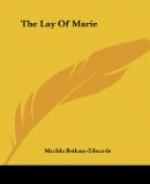NOTE VI.
The broider’d scarf might wave in vain.—p. 57. l. 1.
To such as were victorious, prizes were awarded by the judges, and presented by the hands of the ladies; who also honoured the combatants with the wreath or chaplet, silken drapery, and other appropriate ornaments; and by presenting them with ribbands, or scarfs, of chosen colours, called liveries, spoken of in romance, appear to have been the origin of the ribbands which still distinguish knighthood.
NOTE VII.
Laden with presents and with praise.—p. 57. l. 9.
In the ancient metrical romance of Sir Tristrem, an Irish earl arrives at the court of Cornwall, in the disguise of a minstrel, and bearing a harp of curious workmanship. He excites the curiosity of King Mark, by refusing to play upon it till he shall grant him a boon. The king having pledged his knighthood to satisfy his request, he sings to the harp a lay, in which he demands the queen as his promised gift—
“Y prove the for fals
man,
Or Y shall have thi quen.”
He accordingly carries her off; but her lover Tristrem, who had been absent at the time,
“chidde with the king,
Gifstow glewemen thy quen,
Hastow no other thing?”
The usual gifts to minstrels when they sung were often profuse; rich clothes, &c. They were, by rank, classed with knights and heralds, and permitted to wear silk robes, a dress limited to persons who could spend a hundred pounds of land rent.—Sir Tristrem, edited by Walter Scott, Esq.
Generosity to minstrels is perpetually recommended in the lays, of fabliaux and romances.
NOTE VIII.
The peacock crown with all its eyes.—p. 57. l.17.
According to Menestria and St. Palaye, the troubadours, or poets of Provence, were adorned by the ladies with crowns, interwoven with peacock’s feathers; (the eyes of which expressed the universal attention they attracted)—a plumage in great request, and equivalent to the laurel of the academic bards. Differing, perhaps, little in intrinsic value, but superior in beauty and permanence, and more consonant with the decorations of chivalry. They were not restricted to the troubadours; for such a diadem, ornamented with gold, was sent by Pope Urban III. to Henry II. wherewith one of his sons was crowned King of Ireland; as mentioned by Selden, under the title Lord, and by Lord Lyttleton, under the year MCLXXXVI. A Summary Review of Heraldry, by Thomas Brydson, F.A.S. Edinburgh.
APPENDIX I
Extracts from a Dissertation on the Life and Writings of Marie, an Anglo-Norman Poetess of the thirteenth century. By Monsieur La Rue. Archaelogia, vol. 13.




